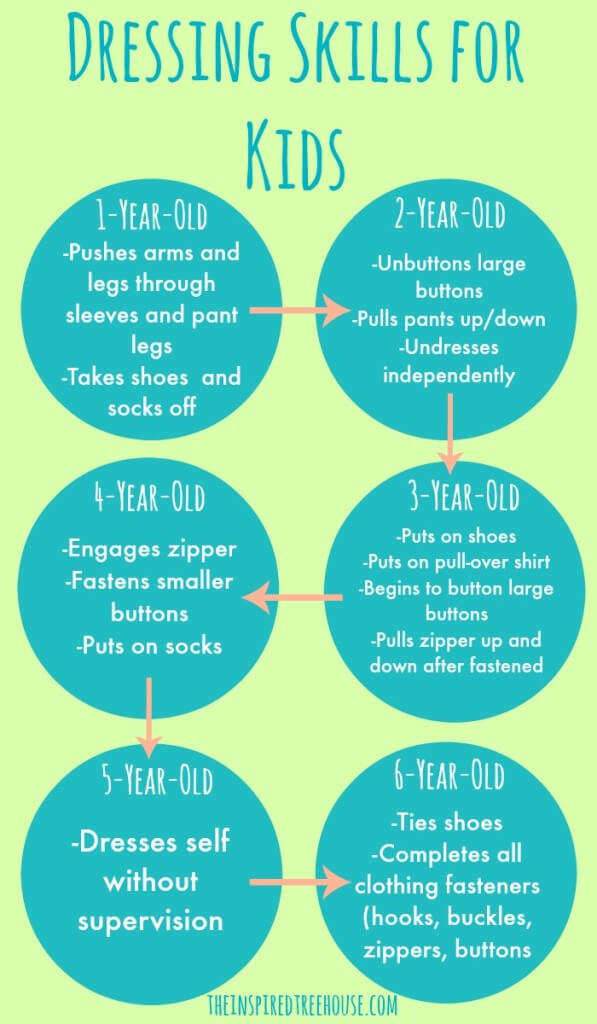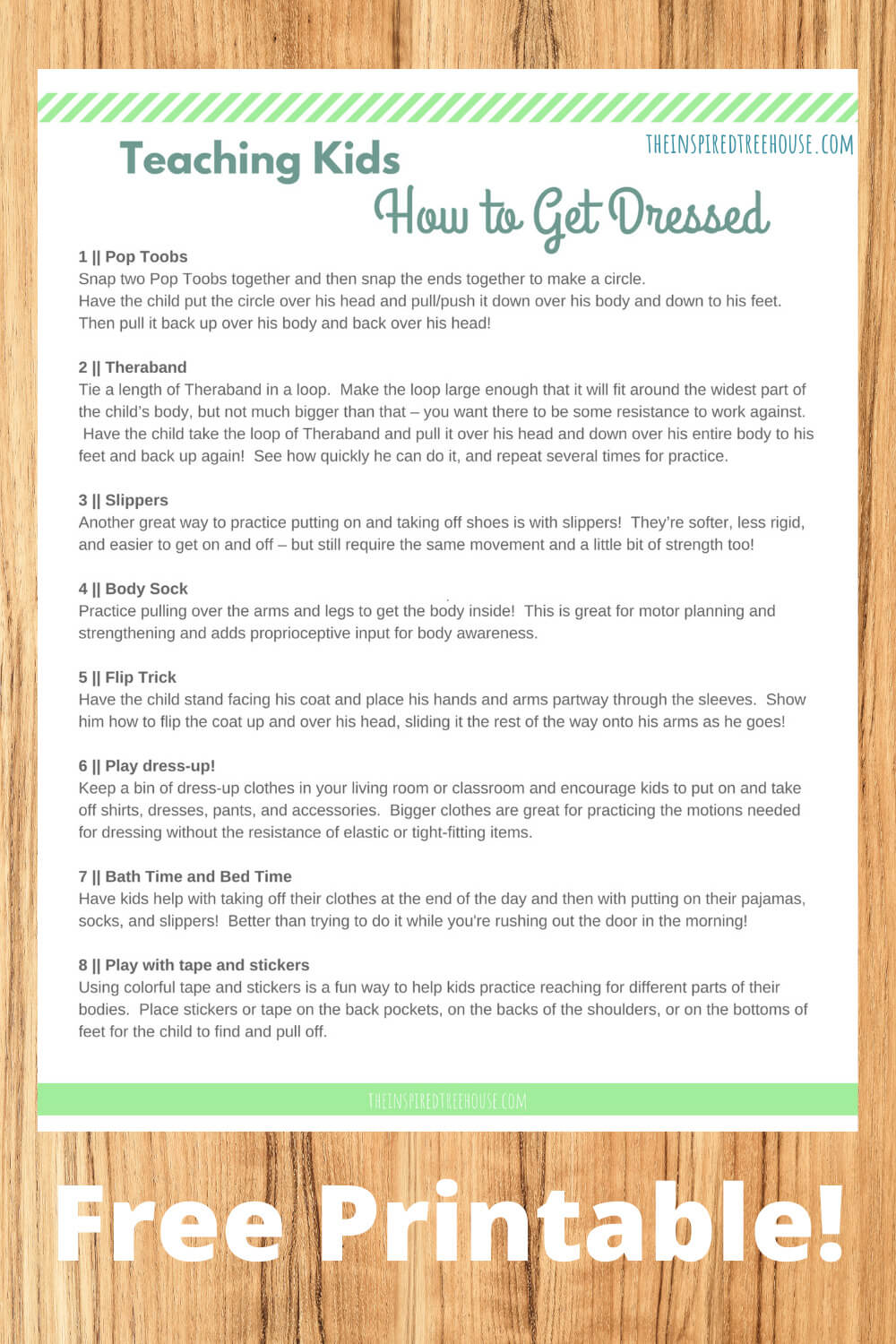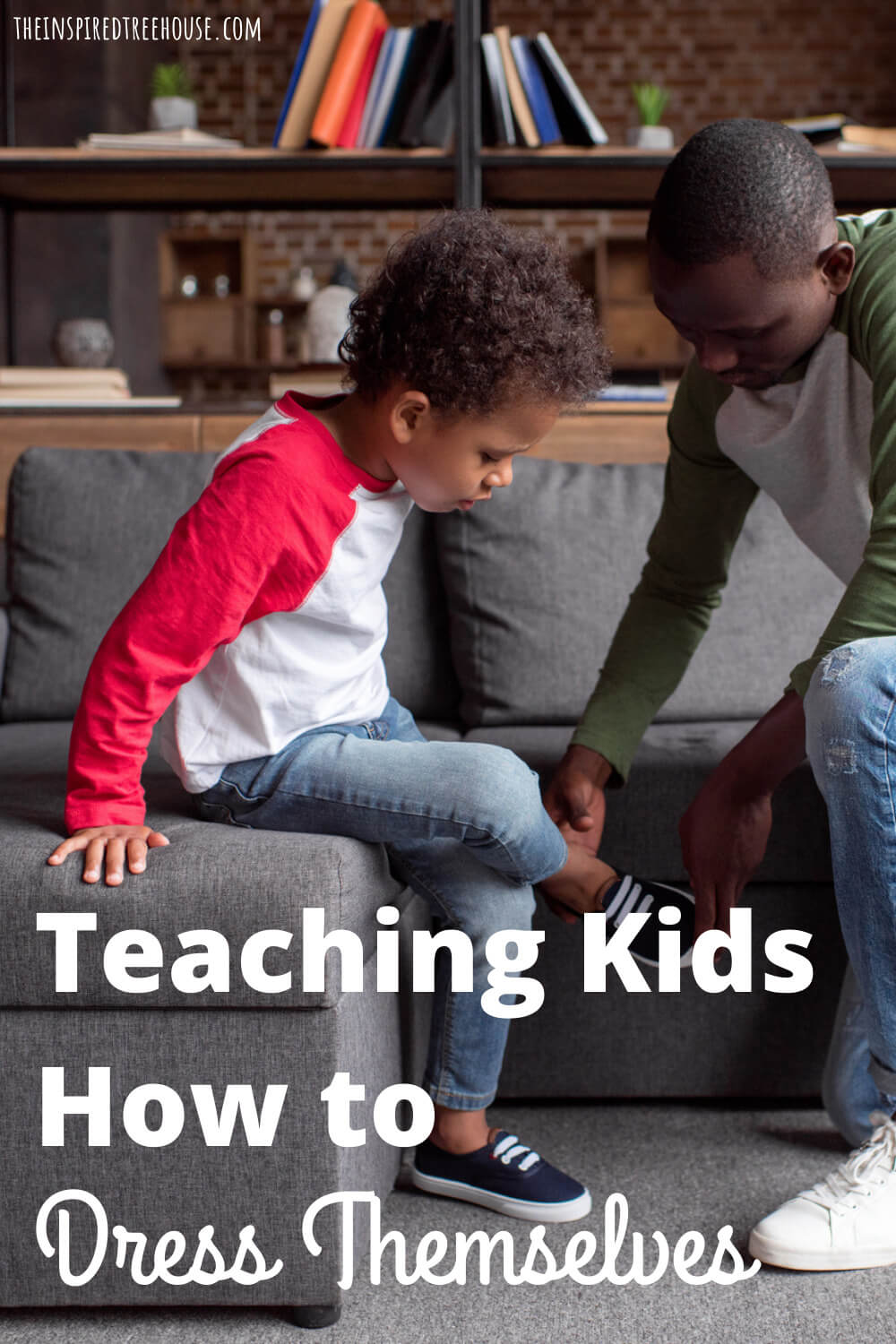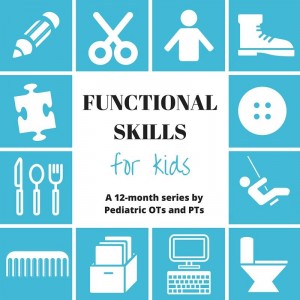Teaching kids how to dress themselves can be a challenge! Try these fun ideas to help kids gain independence and confidence.
This post contains affiliate links. Read more.
If your house is anything like mine, school/work mornings are crazy – making breakfasts and coffee, packing lunches and backpacks, and trying to get out the door in time for the bus or an early meeting.
The mornings can be so busy that I often feel like I’ve lived through an entire day before I even start my day at work!
My kids are now able to get themselves ready in the morning (for the most part), but before this year, one of the things that took the longest was helping them get dressed. Promoting independence with dressing skills is so important for kids’ self esteem, for being able to function independently at school, and for potty training…and it goes a long way toward preserving your sanity on a busy school morning too!
Did you know that kids begin to demonstrate dressing skills as early as one year old? Here are the ages at which most kids are able to complete various dressing skills:

Here are some of our favorite ways to work on independence with dressing skills with kids:
Practice pulling clothing up and down, on and off
1 || Pop Toobs – Snap two Pop Toobs together and then snap the ends together to make a circle.
Have the child put the circle over his head and pull/push it down over his body and down to his feet. Then have him pull it back up over his body and back over his head! Adjust the size of the circle, making it smaller for more of a challenge or bigger for easier practice. This simulates pulling a shirt and pants up and down on the body.
2 || Theraband – Tie a length of Theraband in a loop. Make the loop large enough that it will fit around the widest part of the child’s body, but not much bigger than that – you want there to be some resistance for the child to have to work against.
Have the child take the loop of Theraband and pull it over his head and down over his entire body to his feet and back up again! See how quickly he can do it, and repeat several times for practice.
Make smaller loops with the Theraband and have the child pull them onto and off of his feet to practice with putting on and taking off shoes and socks.
3 || Slippers – Another great way to practice putting on and taking off shoes is with slippers! They’re softer, less rigid, and easier to get on and off – but still require the same movement and a little bit of strength too!
4 || Body Sock – If you don’t have a body sock in your therapy bag or classroom, do yourself a favor and pick one up! These awesome, stretchy things are exactly what they sound like…a sock for your body! They’re great for providing all-over tactile and proprioceptive input and getting them on and off of the body is great practice for dressing!
Use the “flip trick”!
This one is great for increasing your child’s independence with putting on his coat. Place his coat on a table, chair, or couch with the collar toward him and the front of the coat facing up).
Have the child stand facing his coat and place his hands and arms partway through the sleeves. Show him how to flip the coat up and over his head, sliding it the rest of the way onto his arms as he goes!
Play dress-up!
As an OT, this is my favorite way to work on dressing and clothing fasteners with kids. Practicing putting your clothes on is a whole lot more fun when you come out looking like a firefighter or a princess, right?
Keep a bin of dress-up clothes in your living room or classroom and encourage kids to put on and take off shirts, dresses, pants, and accessories. Bigger clothes are great for practicing the motions needed for dressing without the resistance of elastic or tight-fitting items.
Save it for bedtime and bath time!
I often recommend to the families I work with at school to save practice with dressing skills until the evening, when things aren’t as rushed and stressful.
Have kids help with taking off their clothes at the end of the day and then with putting on their pajamas, socks, and slippers! The most important thing is to give kids an opportunity at some point during the day to practice these skills independently!
Work on clothing fasteners
As your child is working on dressing and undressing himself, you can also work in some practice with the fine motor skills needed for buttons, zippers, and other clothing fasteners too!
Try our 10 Days to Conquer Clothing Fasteners plan – 10 days of fun exercises and activities to build independence with buttons and zippers!
Play with tape and stickers
Using colorful tape and stickers is a fun way to help kids practice reaching for different parts of their bodies. Place stickers or tape on the back pockets, on the backs of the shoulders, or on the bottoms of feet for the child to find and pull off.
I have found this activity to be super helpful for kids with tactile hypersensitivities who are very cautious about practicing with clothing during therapy sessions.
Play with scarves and streamers
Try tying a scarf or streamer in a loop (as mentioned above with the Theraband) and pulling it onto and off of the body.
Or play streamer “hide and seek”. Place a streamer in the child’s back pocket, under her shirt, or in the bottom of her pant leg or sleeve for her to reach for and retrieve.
Strengthen those hands!
Strengthening the muscles of the hands gives kids the foundation they need to be able to grasp and pull clothing up and down, on and off. This rubber band activity is a great hand strengthener and these are some of our other favorite activities for building hand strength in kids.
Make a sock helper
This simple DIY sock helper has been a huge hit at our house, helping my middle son learn to put his socks on independently.
Get organized
Before you even start on dressing skills, why not set the child up for success and independence by getting his closet and clothes organized in a functional, child-friendly way?
What are your favorite ways to promote independence with dressing skills? We’d love to hear! Leave us a message in the comments below!


When Do Kids Start to Dress Themselves? | Mama OT
Fine Motor Requirements for Independence with Self-Dressing | Sugar Aunts
Gross Motor Skills and Independent Dressing | Your Therapy Source
Sensory Considerations for Dressing! | Your Kids OT
“Get Dressed!” How to Modify Your Child’s Dressing Routine | MissJaimeOT
Teaching Kids How to Dress Themselves: Activities to extend skills | The Inspired Treehouse
Improving Following Directions with Getting Dressed | Growing Hands-On Kids
Visual Perceptual Skills in Dressing | Kids Play Space
Latest posts by Claire Heffron (see all)
- Pro Tips for Conquering Toddler Separation Anxiety - April 25, 2024
- Cute Zipper Bags for Therapists - April 18, 2024
- Fairy Tale Games and Toys - April 12, 2024



[…] document you wish to write is your resume or CV. In general, writing a powerful resume is vital to CHILD DEVELOPMENT: TEACHING KIDS HOW TO DRESS THEMSELVES – The Inspired Treehouse your career […]